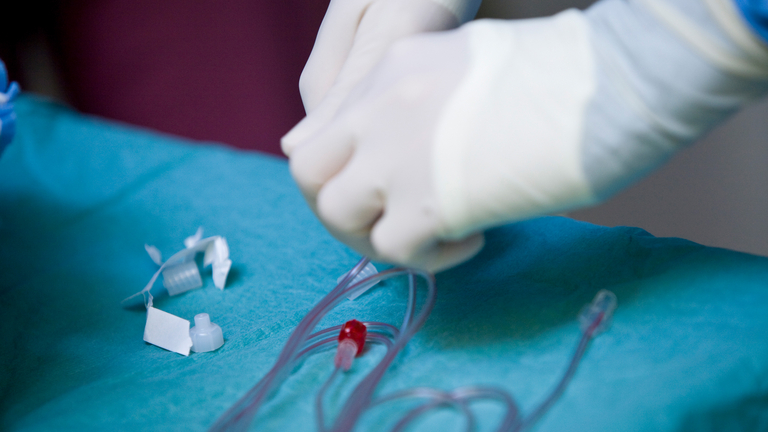
Catheter ablation for cardiac arrhythmia
Difficult-to-treat cardiac arrhythmias that cannot be controlled using medication may respond to a catheter-based procedure targeting areas of abnormal heart tissue. This procedure is known as catheter ablation.
Contact
What is catheter ablation for cardiac arrhythmia?
Catheter ablation is a specialist catheter-based procedure that removes (ablates) abnormal heart muscle tissue, and can eliminate dangerous cardiac arrhythmias. The procedure is used particularly in patients whose cardiac arrhythmia cannot be controlled with medication. Following ablation, the patient's heart rhythm usually returns to normal. This challenging procedure may at times be performed using a robotic navigation system.
What conditions are treated with this procedure?
Catheter ablation is not suitable for all types of cardiac arrhythmias. The procedure is performed in order to treat different types of tachycardia that result in a fast (palpitations) and at times irregular heart rate. These include:
- Atrial fibrillation - this is among the most common cardiac arrhythmias, and is frequently associated with an extremely fast, irregular heart rate.
- Wolff-Parkinson-White-Syndrome (WPW) - an additional pathway connecting the atria and ventricles leads to "short-circuiting", which results in the sudden onset of an extremely fast heart rate. Symptoms are the result of a congenital heart defect, and may be noticed during childhood.
- AV nodal tachycardias - this type of arrhythmia is caused by changes in the electrical pathways in the AV node (atrioventricular node), a sort of electrical relay switch between the atria and the ventricles.
- Ventricular tachycardias - these arrhythmias, which can be life-threatening, originate inside the ventricles, and may occur as a result of scarring from a previous heart attack.
- Other complex arrhythmias
What is the purpose of this type of treatment, and what are the results?
The purpose of catheter ablation is to treat a fast and at times irregular heartbeat, and to restore the heart to its normal rhythm.
In a normal heart, the heart's contraction is controlled by what is referred to as the sinus node, a small area of electrically active cells situated in the right atrium. Here, regular electrical impulses are generated, which are then transmitted to the atria and ventricles, resulting in rhythmic contractions.
A number of different heart conditions can lead to changes in the electrical conductivity of the heart, including for example coronary heart disease leading to chronic oxygen deficiency, or scarring from a previous heart attack. Additional areas of the heart muscle may turn into "spark plugs" and begin to generate electrical impulses. The electrical impulses generated in this manner also often fail to propagate in the normal manner (they may enter a circular pattern). In many cases, this results in a condition referred to as tachyarrhythmia, which is characterized by the heart contracting in an extremely rapid and often irregular manner.
Tachyarrhythmias can be life-threatening, or they can lead to the exacerbation of other conditions. One of the most common arrhythmias, for instance, known as atrial fibrillation, can increase the patient's risk of stroke, as well as further reducing the efficiency of the heart in patients with heart failure.
Aside from drug-based treatment, catheter ablation has also gained increasing importance in the treatment of tachyarrhythmias. Catheter ablation is based on the principle that once additional areas generating electrical impulses have been identified, they can be destroyed (ablated) using a special catheter introduced via the blood vessels in the groin. Ablation usually involves the delivery of high-frequency electrical impulses. Less frequently, ablation may be performed using cold temperatures, ultrasound or lasers.
Ablation is a technically challenging procedure, usually taking a few hours to complete. As a result, interventional cardiologists may sometimes resort to robotic navigation systems, which allow precise navigation of the special catheters that are pushed into the heart. Using 3D imaging technology, the physician can monitor the movement of the robotic system, controlling navigation using a joystick.
Following ablation, the patient's heart often returns to a permanent normal rhythm. An ambulatory ECG can help establish whether treatment has been successful.
A step-by-step description of catheter ablation for arrhythmia
A typical ablation procedure, which also includes an examination of the heart's electrical activity, usually consists of the following steps:
- In order to help the patient relax, a sedative is administered via an intravenous line in the arm. Many patients will even fall asleep.
- After application of a local anesthetic, small incisions are made in the vessels in the groin. Specialist catheters are inserted and advanced using x-ray guidance. The catheter tips carry electrodes, which allow the physician to obtain detailed measurements of how electrical signals travel through the heart (referred to as an electrophysiology study).
- In an attempt to simulate the patient's arrhythmia, the heart muscle is then stimulated using different combinations of electrical impulses, produced by catheters positioned in different areas of the heart muscle. Measurement results can then be analyzed to establish the exact source of the arrhythmia.
- Once the faulty electrical pathways have been identified, the physician can advance the catheter used for tissue ablation and aim it directly at the area of the heart that contains abnormal tissue. The physician uses 3D imaging technology to check catheter positioning. High frequency electrical impulses are then used to heat the abnormal tissue areas to a high temperature, destroying the tissue in the process. The location of the abnormal pathways may be well known, such as when dealing with certain types of arrhythmia, e.g. atrial fibrillation. In these cases, the physician will target these areas directly.
- The interventional cardiologist uses the catheters to obtain measurements, and to produce electrical stimuli to check whether the specific arrhythmia can still be triggered. If this is the case, the physician may ablate additional abnormal areas.
- Once ablation has been completed, the catheters are removed from the vessels in the groin, and pressure bandages are applied to the entry sites.
